April 18, 2008
Air Date: April 18, 2008
FULL SHOW
SEGMENTS
Green Goes to the Boardroom
View the page for this story
More and more companies are finding ways to make economic growth with environmental benchmarks part of their mandates. Fred Krupp, author of “Earth: The Sequel” and president of Environmental Defense Fund, tells host Steve Curwood, the profit motive that helped create global warming can also help solve it. (06:30)
Green Profits Can Still Impoverish the Earth
View the page for this story
David Korten, author of “The Great Turning: From Empire to Earth Community” and host Steve Curwood continue Living on Earth’s Earth Day discussion on the greening of corporations. Korten says green consumption won’t solve the larger problems at the root of environmental degradation. (05:30)
Earth Day for Everyone
View the page for this story
From the hip-hop group The Roots to music producer Russell Simmons, many of this year’s Earth Day performances are meant to draw a diverse crowd. Steve Curwood talks with Kathleen Rogers, president of the Earth Day Network, about efforts to expand environmentalism’s base beyond middle-aged white people. (02:40)
Vision of a Sustainable City
/ Cecilia VaismanView the page for this story
In honor of Earth Day, Living on Earth revisits some of our favorite stories. Today, we go to the southern Brazilian city of Curitiba. When reporter Cecilia Vaisman visited Curitiba in 1994, she learned how a city with a growing population and outdated infrastructure transformed into a sustainable and wonderfully livable city, with lots of green space, recycling programs, and an efficient rapid transit system. (15:25)
Urban Visionary
View the page for this story
Curitiba, Brazil’s model sustainable city, was largely the brainchild of Jaime Lerner. As three-time mayor of the city, he created a rapid transit bus system, increased the amount of green space, and encouraged children and adults alike to recycle. Jaime Lerner joins host Steve Curwood in the LOE studios and says all cities have the potential for environmental success. (09:00)
Greening Minneapolis
View the page for this story
Minneapolis Mayor R.T. Rybak tells host Steve Curwood about the unique environmental projects that have made Minneapolis one of the greenest cities in the country. (05:20)
Earth Day at 38
View the page for this story
Host Steve Curwood reflects on how things have changed since the first Earth Day and what might brighten the future. (05:50)
Show Credits and Funders
Show Transcript
Host: Steve Curwood
Guests: Fred Krupp, David Korten, Jaime Lerner, Kathleen Rogers, R.T. Rybak
Reporters: Cecilia Vaisman
[THEME]
CURWOOD: From Public Radio International – this is Living on Earth.
[THEME]
CURWOOD: I’m Steve Curwood. As Earth Day reaches its thirty-eighth birthday – green is becoming the new red, white and blue, as love of country is increasingly being seen as love of the land.
RYBAK: The more we connect people back to the magic of the places we live in, the more they will respect them and take the tough actions that we all need to take to be living in better harmony.
CURWOOD: Cities move to become more livable. Also this Earth Day, the environment is showing up in more and more business plans to the applause of some activists:
KRUPP: For some problems like global warming, it’s really not the question of saying ‘don’t do this, don’t do that.’ We have to get corporations, engineers, entrepreneurs, to be the center of problem solving if we’re going to get the innovation we need.
CURWOOD: But others say corporations are a big part of the problem. That and more this week on Living on Earth. Stick around!
[MUSIC: Boards Of Canada “Zoetrope” from “In A Beautiful Place Out In The Country” (Warp Records 2000)]
ANNOUNCER: Support for living on earth comes from the National Science Foundation and Stonyfield Farm.
Green Goes to the Boardroom

Fred Krupp, president of Environmental Defense Fund, says it’s time to use market forces to solve environmental problems. (Photo: T. Charles Erickson)
[THEME]
CURWOOD: From the Jennifer and Ted Stanley Studios in Somerville, Massachusetts – this is Living on Earth. I’m Steve Curwood.
This year, Earth Day is 38 years old, and we know what that means: it’s nearly middle aged, time to settle down. Gone are the bullhorns and barricades of Earth Day 1970, when millions paraded to protest the ecological destruction of our planet. Instead these days it seems the call for environmental action is being taken more to the boardrooms than to the streets.
Some see this shift as a softening in the resolve of one-time protesters who have since mellowed into parents and grandparents. But others see the trend as the maturation of a movement that must reconcile with the establishment to bring about meaningful change. We’ll hear from both perspectives today, and we start with Fred Krupp, longtime president of Environmental Defense Fund and co-author of the new book, Earth: The Sequel. Hello, Fred.
KRUPP: Hi Steve, how are you?
CURWOOD: I’m good. And, tell me – your book title scared me a bit. Earth: The Sequel. Does this mean we’re gonna need another planet?
KRUPP: No. It means that we all know the current story: melting glaciers, rising sea levels, strengthening hurricanes, dying coral reefs. It’s sort of like a slow motion, sci-fi horror movie unfolding before our eyes, and the stakes are very real and very grave. The sequel is all about how we get out of this fix. It’s a hopeful story about inventors and engineers figuring out what we need to do to generate clean energy and have a future thriving planet.
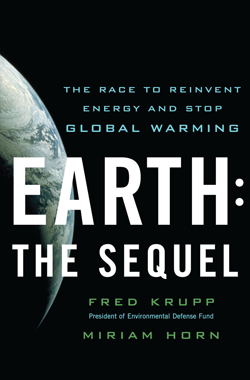
In “Earth: The Sequel,” Fred Krupp describes an historic transformation of the energy industry that will create a new wealth and slow the warming of the planet. (Photo: T. Charles Erickson)
KRUPP: They are indeed. You know, it’s an irony that the profit motive got us into this fix, because the market system does not account for the cost of global warming pollution that we throw into the air. Once we pick up that profit motive and turn it upside down and align it with what we need, we actually are able to harness entrepreneurial energy, thousands of inventors and businessmen, who suddenly are required to inculcate in every decision the cost of throwing global warming pollution into the air, and are rewarded only when they realize the benefit of taking global warming pollution out of the smokestacks, or even, if they can do it, right out of the air.
CURWOOD: Now – it’s true. Every week we seem to hear about some brilliant new technology that’s gonna help address the problem of global warming. But we’ve yet to see much change. Emissions keep rising. What’s it gonna take for all these great ideas to become reality?
KRUPP: Well the key thing, Steve, is, we’ve never solved an air pollution problem anywhere in he world without putting a legal limit or cap on the amount of pollutants that could go into the air. And so these technologies, whether they’re solar energy or wind power or wave power or geothermal – they are enormously cheaper for the atmosphere because they involve no pollution, but they now are being asked to compete while we give this huge subsidy to burning fossil fuels.
So what I consider really the starting gun to start this great and important race is government in the United States clamping down, putting a legal limit that declines over time on global warming pollution being dumped into the sky.
CURWOOD: So, in the meantime, we’re waiting on our government to do something here. Uh, what should we do while we wait for these changes to take place? I mean, the United States is good for, what, a quarter of the world’s carbon dioxide emissions? And we’re, what, five percent of the world population?

Fred Krupp, president of Environmental Defense Fund, says it’s time to use market forces to solve environmental problems. (Photo: T. Charles Erickson)
CURWOOD: You’re trained as an attorney. Environmental Defense Fund is an organization that is known as – hey, if you pollute, you know, we’re gonna put a lawsuit down the chute.
KRUPP: Absolutely. Our initial, if informal, motto was, ‘sue the bastards.’ But we have found that if we can get the business community to work for our goals, that’s even more effective.
CURWOOD: At the first Earth Day, corporations were really in the center of the target, seen really as engines of greed and of pollution. Obviously your take on how to solve environmental problems differs vastly from that approach. To what extent do you think those protests were a mistake?
KRUPP: I don’t look back with regret; I think it was important that we checked the worst abuses. It was important that we ban lead, it’s important that we get mercury out of the system – there are some abuses that just need to be banned and outlawed. But for some problems like global warming, where pollution is so widespread from so many activities, it’s really not the question of saying, ‘don’t do this, don’t do that’ – it’s the answer that has to be constructing the future. We have to get corporations, engineers, entrepreneurs, to be at the center of problem solving if we’re gonna get the innovation that we need.
CURWOOD: In your view, what can’t the market do for global warming?
KRUPP: The market can’t do what only we as citizens can do. And that is, say to our elected officials, ‘Enough. We need a legal limit or a cap that declines as fast as the scientists tell us it must decline. The market can’t and will never do that. That’s something only you and I as citizens can do. And it’s time to rise up and demand that every senator and every Congressman be for a strong climate change bill.
CURWOOD: Fred Krupp is president of the Environmental Defense Fund and recently wrote Earth: The Sequel together with Miriam Horn. Thank you so much, Fred.
KRUPP: Thank you, Steve.
Related links:
- To hear a longer version of Steve Curwood’s conversation with Fred Krupp, click here
- To learn more about Fred Krupp’s book, click here
- Environmental Defense Fund website
Green Profits Can Still Impoverish the Earth
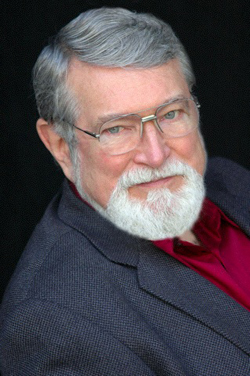
Author David Korten says the human instinct toward cooperation, not competition, will solve the world’s environmental problems. (Courtesy of David Korten)
CURWOOD: David Korten is far more skeptical about the willingness of business to address the profound challenges of environmental change. Mr. Korten is an author and social researcher whose books include When Corporations Rule the World, as well as his latest volume, Great Turning: From Empire to Earth Community. He says solving the world’s environmental problems will require much more than the current trend of corporations painting themselves a glossy shade of green.
KORTEN: Well I think it certainly reflects a change in the public consciousness, and awareness on the part of corporations that they had better appear green or they’re gonna lose a lot of consumer loyalty. The unfortunate reality, however, is that the institution itself is legally structured in a way that it is very difficult for it to make any choices that do not increase its profits.
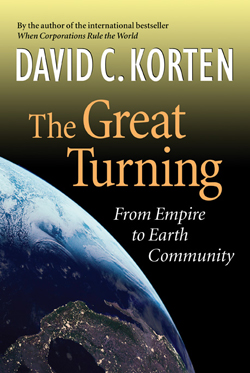
David Korten’s book describes the structural changes he believes are needed to improve environmental degradation and economic inequality. (Courtesy of David Korten)
KORTEN: Well, basically, you know, if you can give the big corporations enough subsidies so it’s worth their while to move ahead with environmental technologies, uh, they will respond. But that is gonna be, normally, at an enormous cost to taxpayers. And the thing that’s often not mentioned is if you’re increasing the profits of corporations, you’re basically serving the interests of the wealthiest investors over the working people who actually produce goods and services.
CURWOOD: In these recent years we’ve seen a green version of virtually every product coming out on the market, whether it’s a car that gets better mileage or a cleaner that’s less toxic, or a home that has a lower carbon footprint. To what extent can we consume our way to conservation?
KORTEN: If we substitute a green product for a toxic, or energy inefficient product, that is – that’s an advantage. But all of this misses the point of the extraordinary seriousness of our global-scale problem, and the larger fact that we are consuming Earth’s resources at a much more rapid rate than what can be regenerated. One of the things we have to do is get beyond this myth that as the economy grows, we bring the bottom up, and so, we don’t need to worry about the people on the top; we will all increase our consumption. And that’s, that’s a major blind spot in economics – the idea that on a finite planet, you can have infinite growth.
CURWOOD: So to what extent are you optimistic about the future then?
KORTEN: Well, I sometimes, (sigh) frankly, Steve, get very scared, because the rate at which our environmental systems are collapsing is terrifying. Ironically, one of our best hopes may be the fact that we are moving rapidly into a serious collapse of the financial system. This is not a normal business cycle, because we are also running up against very real limits. We’ve got more and more people competing for this diminished resource base, in everything from oil to fresh water.

Author David Korten says the human instinct toward cooperation, not competition, will solve the world’s environmental problems. (Courtesy of David Korten)
And this is not going to be a normal recovery. Now, as harsh and as difficult as a financial collapse will be, it could in some ways be considered a blessing because it forces us to step back and ask some of these deeper questions about what we want, and to consider reforms that previously were off the table – very much like what happened with the Great Depression of the 1930’s.
CURWOOD: Where do you get the political will to make such deep, structural changes in society? Redistributing wealth has been a holy grail of social progressives for a long time, and it seems that we’re if anything, going in the opposite direction.
KORTEN: We’re definitely moving in the opposite direction. Now, you know, I think this environmental crisis creates an extraordinary moment of opportunity. It’s often presented that the changes we need to make will involve serious sacrifice.
But one of the things I learned in all my experience living around the world and in working with global citizen movements, is that for all the diversity of the world’s cultures and peoples, when you get right down to it most of the world’s people want a world in which our children are healthy and happy, in which we have strong families, in which we have strong communities, caring communities, and a healthy natural environment. Once we begin moving beyond meeting basic human needs, real happiness depends on the strength of our communities and families. So it’s actually – we face a combination of the imperative to change as a price of our very survival as a species, combined with the opportunity to create the world that most of us actually dream about, that we’re told is beyond our reach.
We’re so locked into stories that are very partial or even false – including the idea that life is fundamentally competitive and that progress comes through competition – if one steps back and takes a deeper look at living systems, as some of the people at the forefront of the new biology are doing, you begin to recognize that at a deeper level, life is a fundamentally cooperative project.
CURWOOD: David Korten’s latest book is called Great Turning: From Empire to Earth Community. Thank you so much for taking this time.
KORTEN: It’s been a great pleasure, Steve.
Related links:
- To hear a longer version of Steve Curwood’s conversation with David Korten, click here
- David Korten’s website
- To learn more about building an Earth community, click here
- The People-Centered Development Forum
[MUSIC: Ketil Bjornstad/Terje Rypdal “The Sea V” from ‘Life In Leipzig’ (ECM Records – 2008)]
CURWOOD: Coming up – how green was my city. Keep listening to Living on Earth.
[MUSIC: Charlie Hunter/Chinna Smith/Ernest Ranglin : “Island In The Sun” from Earth Tones (Nature Sounds Records 2005)]
Earth Day for Everyone
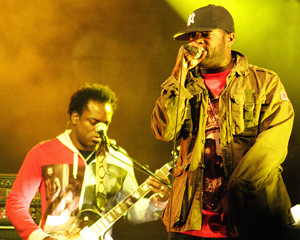
Kirk Douglas and Black Thought from The Roots performing in San Jose, California. The hip-hop band is headlining the flagship Earth Day event in Washington, D.C., part of efforts to broaden environmentalism’s appeal. (Photo: SolisPhotography.org)
[MUSIC: The Roots “Don’t Say Nuthin” from ‘The Tipping Point’ (Okayplayer Records – 2004)]
CURWOOD: It’s Living on Earth. I’m Steve Curwood.

Last year’s Green Apple Festival in San Francisco. Organizers want the Earth Day crowd to get more and more diverse. (Courtesy of the Earth Day Network)
Kathleen Rogers is the president of the Earth Day network. Ms. Rogers, how did you come to feel Earth Day needs more diversity?
ROGERS: I was sort of dumbstruck – when we started doing surveys of the environmental membership, and I discovered that the average age was somewhere between 51 and 55 and we were almost exclusively white. And I found that disturbing. It was a study that we did ourselves, and we all took a deep breath and said, ‘we need to change things.’ If we want to be powerful, then we need to bring many more people into this movement.
CURWOOD: Why has being green also traditionally meant being white?
ROGERS: Well, I think because, in large part the membership in the environmental community has been white. And so, if you’re looking at the first Earth Day event, which was part anti-war, part environment, and you look at subsequent events, people tend to think about the environment after they’ve taken care of their basic needs. And so the upper-middle class population of this country – again, largely white for many, many years – were those tried and true members that also became activists.
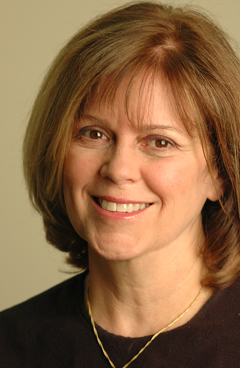
Kathleen Rogers wants the “new environmentalists” of the 21st century to be made up of people of all colors, classes, and ages.
(Courtesy of the Earth Day Network)
CURWOOD: What does the environmentalist of the future look like to you?
ROGERS: Well Earth Day Network is in 180 countries, and, so we don’t have that issue anywhere in the world except in the United States, where the environmental community has largely been relegated to upper-middle class, white people. And so the environmentalist of the future reflects the demographic of our country. And that is something we have to work hard to change, and this Earth Day, I hope, will be a giant step in that direction.
CURWOOD: Kathleen Rogers is the president of the Earth Day Network. Thank you so much.
ROGERS: Thank you very much.
Related link:
To learn about this year’s Earth Day events, click here
Vision of a Sustainable City
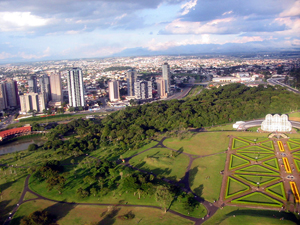
The southern Brazilian city of Curitiba and its botanical garden.(Photo: Jose Vladimir)
CURWOOD: To mark Earth Day, we are presenting and updating some of our favorite stories from years past. And with the theme of sustainable cities common this year in many locales, we thought we’d go back to 1994 and visit a city in Southern Brazil called Curitiba. Curitiba is often cited as an example of how to make cities more livable. Its transformation didn’t take a lot of money or even a lot of time. But it did take the vision of a man who is an architect and three-time mayor of Curitiba, Jaime Lerner.
When our story was produced back in 1994, the city had a million and half residents and had made great strides in dealing with garbage, pollution and congestion. Later in today’s program, we’ll catch up with Jaime Lerner to hear how his Curitiba is faring today, but first here’s our story by reporter Cecilia Vaisman.
[PEOPLE CHATTING; TRAFFIC]
VAISMAN: For Paul Peter Constantinides, an architect and city planner, coming to Curitiba is like a pilgrimage.
[CONSTANTINIDES SPEAKING PORTUGUESE]
TRANSLATION VOICEOVER: It is the only city in my region that has an urban design that is correct. It prioritizes the quality of life, which is the most important thing.
VAISMAN: It’s the morning of the first day of a workshop for city officials at the Jaime Lerner Institute, Curitiba’s urban planning think tank, and Constantinides and a dozen other mayors, vice mayors, and city officials from Brazil and Mexico are touring the city.
[NOISE OF ENGINES/VEHICLES ON ROAD]
VAISMAN: Constantinides works in Jacareí, a small city about 200 miles from here. He says Jacareí is growing fast; it’s polluted, and the city’s roads are a mess. Here in Curitiba, Constantinides stares out the window, marveling at the sights. Every few blocks there’s a park. The city’s downtown is laced with pedestrian promenades; no trash clogs the gutters; no stains from smog on the seventeenth-century architecture – and everywhere, traffic flows smoothly.
[TRAFFIC]
[CONSTANTINIDES SPEAKING PORTUGUESE]
TRANSLATION VOICEOVER: When you do urban planning, sometimes you favor the car or public transportation. But here, everything’s balanced; everybody wins: the pedestrian, the driver of the car, and the user of the bus. And also, the landscape is beautiful.
[CITY NOISE; PEOPLE TALK; BUS STOPS]
[WOMAN SPEAKS IN PORTUGUESE IN BACKGROUND]
VAISMAN: The first stop is Curitiba’s University of the Environment. Set up by the city government, the university provides free classes to citizens on everything from botany to recycling.
VAISMAN: A walkway made of rough boards winds across a marsh and through dense forest.
[CLASSICAL MUSIC PLAYS]
[BIRDS CHIRP; PEOPLE CHAT AND WALK ALONG WOODEN WALKWAY]
VAISMAN: It leads to a clearing surrounded by walls of sheer stone. Black-necked swans glide across a pond, and classical music is piped in over a loudspeaker.
[CLASSICAL MUSIC PLAYS]
VAISMAN: Until a few years ago, this was an abandoned quarry. When Curitiba’s three-time mayor Jaime Lerner saw this space, he had a flash of inspiration, sketched out a rough design for a small building made of recycled materials, and a couple of months later, the university was completed. Its low-tech and low-cost ideas like this that the city officials have come here to see.
[TOMAIN SPEAKING PORTUGUESE]
TRANSLATION VOICEOVER: This is very beautiful. Whoever had the idea of doing this is brilliant.
VAISMAN: Manuel Tomain is a top official in a city that’s the capital of stainless steel production in Brazil. He says that smelters have polluted his city and left large tracts of vacant land. He came to Curitiba desperate for solutions.
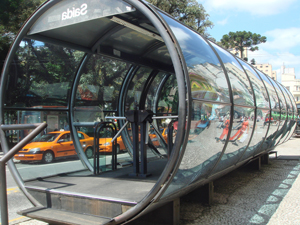
A bus stop in Curitiba. Riders pay before entering so they can board the bus as quickly as boarding a subway train.(Photo: Sasha Aickin)
TRANSLATION VOICEOVER: I’m going to do anything, find anything, an inspiration, a quarry, a pile of rocks, whatever, to see if I can do something similar to this. I came to see what works and see which ideas I can steal.
[CLASSICAL MUSIC FADES]
[PEOPLE TALK; PAPER RUSTLES]
VAISMAN: At the next stop, the officials file into an auditorium, and the man they’re all eager to meet strides to the podium of the institute, which bears his name.
[PEOPLE CLAP]
[LERNER SPEAKING PORTUGUESE]
VAISMAN: I have the honor of receiving you here, Jaime Lerner tells them, at a time when cities can play a decisive role in the future of our country
[LERNER SPEAKING PORTUGUESE]
VAISMAN: The son of Polish-Jewish immigrants, Lerner is an architect and urban planner. For most of the last 25 years, he’s been mayor of Curitiba and master minded the city’s environmental urban design. Legally, he can’t become mayor again, but recently he was elected governor of the state of which Curitiba is the capital. And Lerner consistently tops public opinion polls as the most popular politician in Brazil. Admirers come from all over the world to listen to Lerner’s gospel.
LERNER: I’m sure that every city in the world, in less than one year, can improve on environmental issues. It’s very important, the start of the process of change in the city. Don’t be afraid to start, even if it's not so correct. But if you don’t start, there is no – there is nothing to correct.
VAISMAN: Back when Lerner first became mayor of Curitiba in 1971, Brazil was going through its economic miracle, and most Brazilian mayors embraced the idea that bigger is better. Brasília, the country’s capital, had recently been built from the ground up in only five years. São Paolo’s industries boomed, and in a decade, the city’s population grew by more than half.
But Lerner believed that unrestrained growth would eventually choke cities and make them unlivable. So he hired a team of young architects and urban engineers to develop cheap and environmentally sustainable solutions to basic urban problems like public transportation and garbage. They built special schools for street children, and converted old buses into roving classrooms to provide job training in typing and hairdressing for people living in shantytowns.
Lerner says it’s crucial to start small and look for simple solutions.
LERNER: There’s a lot of people, sellers of complexity. And sometimes it’s not the question – it’s not so complex. I think one of the secrets of Curitiba – we are not afraid of trying simple solutions.
VAISMAN: Like Curitiba’s reforestation program, launched 15 years ago. The government provided saplings, and the citizens rolled up their sleeves to plant them – a million and a half trees. Now Curitiba has more green space per citizen than any other major city in Brazil.
LERNER: When, the people, they feel respected, there is that, that kind of a shared cause: the people with their city. And that means a lot.
[WOMAN SPEAKING PORTUGUESE IN BACKGROUND]
VAISMAN: After meeting with Lerner, the officials split up into small groups. A group of Mexican officials and bus drivers from the city of León, Guanajuato, decide to check out Curitiba’s transportation system.
FERNÁNDEZ SPEAKING SPANISH
TRANSLATION VOICEOVER: The system in our city is very, very bad.
VAISMAN: Rafael Fernández Pérez works in the office of urban affairs in the city of León.
[FERNÁNDEZ SPEAKING SPANISH]
TRANSLATION VOICEOVER: Hardly anybody gets some buses in León. No children, no pregnant women, no middle class or older people. The only people that use them are people who don’t have any choice. Other people travel by cars, so the traffic jams are terrible. Here, in Curitiba, they have three times more cars than us, but people don’t use them very much.
[PEOPLE TALK DURING TOUR]
VAISMAN: The officials pull up to Curitiba’s transit authority, where the manager of operations starts off his presentation with a videotape touting Curitiba’s bus system.
[MUSIC FROM THE VIDEOTAPE PLAYS]
VAISMAN: On the screen, sleek buses whiz through the city’s streets, carrying smiling passengers. The narrator explains that an efficient bus system can save money, reduce air and noise pollution, and improve the overall quality of life of the city.
[NARRATOR’S VOICE AND FROM VIDEO]
VAISMAN: When Jaime Lerner first became mayor, he was urged to build a subway, but decided instead that the more practical and cost-efficient solution was to improve the city’s bus system with a network of express bus lanes linking downtown to outlying areas. Now a third of the city’s residents have switched from cars to riding buses, and exhaust fumes have been reduced by a third.
The system pays for itself. The government contracts out to private companies on a competitive basis. The city collects fares, and in turn pays the bus companies by the number of miles they drive each day.

Curitiba and its botanical garden. (Photo: Jose Vladimir)
VAISMAN: On the other side of town, Ricardo Ontiveros, a sanitation commissioner from Mexico, is inspecting Curitiba’s recycling program.
[ONTIVEROS SPEAKING SPANISH]
TRANSLATION VOICEOVER: Garbage is a huge problem. The only thing we do when we take it to a landfill – it’s like the servant who sweeps the house and hides the garbage under the rug. There will come a day when garbage will suffocate us totally.
[GARBAGE TRUCKS WHIR; MAN TALKS IN BACKGROUND]
VAISMAN: In Curitiba, a fleet of green trucks owned by a private company goes door to door to collect recyclable material. 70 percent of Curitiba’s residents recycle, the result of a massive education campaign in schools and middle-class neighborhoods.
And perhaps more importantly, the city also came up with an innovative program in poor neighborhoods, which gives out food and bus coupons in exchange for bags of recyclable glass, plastic, aluminum, and tin cans.
[ONTIVEROS SPEAKING SPANISH]
TRANSLATION VOICEOVER: This program is ingenious, because it solves several problems at once. The poor have an incentive to recycle, and at the same time they’re encouraged to use public transportation.
[MACHINES WHIR; CANS AND BOTTLES CLINK]
VAISMAN: And in this facility, the recyclable materials is separated by homeless people and recovering alcoholics, who work in exchange for a small salary and room and board. In his city, Ontiveros says about 250 people live next to the dump, and survive by combing through the trash and salvaging whatever they find. He says many of these people get seriously ill.
[ONTIVEROS SPEAKING SPANISH]
TRANSLATION VOICEOVER: It’s degrading to work in a dump. It’s humiliating, and it shouldn’t be.
VAISMAN: Ontiveros says he’d like to give the people back home jobs and a plant like this.
[WHIR OF MACHINES FADES]
[PEOPLE TALK]
VAISMAN: At the end of the day, the officials head back to their hotel. Many of them are reeling with possibilities and trading ideas about the new programs they want to establish when they get home.
[TROJAN SPEAKING PORTUGUESE]
TRANSLATION VOICEOVER: I’m excited, but frankly, I feel a little sadness too.
VAISMAN: Luiz Augusto Trojan, the secretary of urban development in a small town of a neighboring state is unsure. He says he wonders if Curitiba’s success can really be repeated elsewhere.
[TROJAN SPEAKING PORTUGUESE]
TRANSLATION VOICEOVER: The main difference between my city and this city is a person like Jaime Lerner, a political figure with credibility. Curitiba is already so changed. People have become used to these things. It’s irreversible.
In my city, people are used to ugliness. People there don’t want trees; they cut down the trees in the parks. They do things that are insane, nuts. So we have to start from the beginning. But without that visionary person, it’s very difficult.
[MAN SPEAKING PORTUGUESE]
VAISMAN: A man sitting nearby has similar concerns. Alexandre Pera Cerearo, from the state of Rio de Janeiro, says that residents of Curitiba are very different than the people in his city.
[CEREARO SPEAKING ANIMATEDLY IN PORTUGUESE]
TRANSLATION VOICEOVER: In my city, the culture’s very different. And the climate is different – people go to the beach, they aren’t disciplined. Here it’s colder – people stay indoors and read books. They think more about things. I know it all depends on the education. If you start slowly educating people in grade school, who knows – maybe in ten years, my city could be better.
VAISMAN: In fact Curitiba is very different than most other cities in Brazil. Even before Jaime Lerner became mayor, Curitiba had a long history of civic responsibility and community participation. Curitiba’s population, mostly of Polish and Italian ancestry, is more culturally homogenous than in other parts of Brazil. Curitiba has a strong middle class, without the huge income disparities between rich and poor common throughout the country. And the city government has traditionally been free of corruption. Another key to Curitiba’s success is the fact that Lerner and his team were in power for nearly a generation, providing consistent policies from one administration to the next.
Jaime Lerner admits that all of those factors have helped Curitiba be successful. But he insists that officials anywhere can implement simple solutions that can quickly improve the quality of life for their city’s residents. In turn, he says, city leaders will gain credibility and support for future projects.
LERNER: Many mayors in big cities, they have always that kind of excuse. Uh, you know, we cannot change because, you know, it’s a big problem. The scale of the problem is not an excuse for not trying to change. It has nothing to do with the possibility of change.
Several cities have already adopted some Curitiba-type solutions, like recycling and express buses. Lerner says these won’t solve all their environmental problems, but it’s an important beginning in a world where increasing numbers of people live in cities.
VAISMAN: I’m Cecilia Vaisman reporting.
[MUSIC: Moacir Santos “Sou Eu…” from ‘Ouro Negro’ (Adventure Music – 2001)]
CURWOOD: Coming up – fourteen years after we first aired our documentary on Curitiba, we speak with Jaime Lerner, the man whose vision helped create the model sustainable city.
LERNER: I think the merit of – the credit of Curitiba is we had the courage to make simple solutions.
CURWOOD: The simple solutions that shaped Curitiba and how other cities could follow its lead. That’s just ahead. Stay tuned to Living on Earth!
ANNOUNCER: Support for the Environmental Health Desk at Living on Earth comes from the Cedar Tree Foundation. Support also comes from the Richard and Rhoda Goldman Fund for coverage of population and the environment. This is Living on Earth on PRI: Public Radio International.
[MUSIC: The Bad Plus: “This Guys In Love With You” from Prog (Columbia 2007)]
Urban Visionary
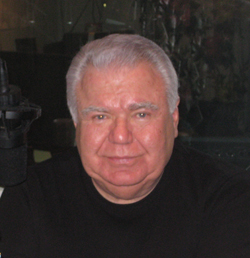
Jaime Lerner is the three-time mayor of Curitiba.
CURWOOD: It’s Living on Earth, I’m Steve Curwood. Curitiba, the Brazilian city we just heard about in Cecilia Vaisman’s documentary, would not be the environmental success it is without the leadership of Jaime Lerner.
Jaime Lerner is an architect and urban planner. He was also the mayor of Curitiba for three terms, and served twice as Governor of the Brazilian state of Paraná. His leadership was largely responsible for the transformation of the city. Today Jaime Lerner is a professor of urban and regional planning at the federal university of Paraná, and is this year’s keynote speaker at the Ecocity World summit in San Francisco. He joined us in our studios and together we listened to our 1994 story.
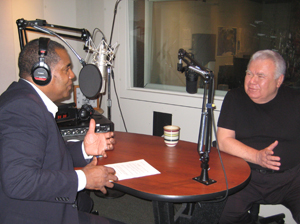
Jaime Lerner(r) talks with host Steve Curwood (Photo: Eileen Bolinsky)
CURWOOD: The city’s much bigger now, though – what, it went from, what, 1971, a million people, million and a half people – now it’s tripled in size?
LERNER: The population tripled since 1971, but many issues, they are improving more and more. For instance, the average of green areas is 52 square meters of green area per inhabitant. The system of transport is getting better. We started, I remember, 25 thousand passengers a day. Now we have two million four hundred thousand passengers. And the system works well.
CURWOOD: You said you had 52 square meters of green space per resident?
LERNER: Yes.
CURWOOD: And what was that back when you started in Curitiba.
LERNER: In ’71, a half square meter per inhabitant.
CURWOOD: Where did you get all this green space?
LERNER: It’s an incredible story. We started the wrong way. (laughs)
CURWOOD: The wrong way?
LERNER: Well, we started wanting to build squares – you know, that kind of planning – every kilometer – uh 500 meters, we should have a grid of parks. And all of a sudden we realized that it will take years and years, a lot of resources, and, until the trees will grow up – and all of a sudden we understood that it’s more important saving the existing woods.
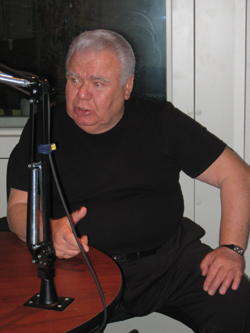
Jaime Lerner says the secret to success in recycling is to "start with the children." (Photo: Eileen Bolinsky)
CURWOOD: Now, as I understand, the city of Curitiba has the highest rate of separating garbage of virtually any city in the world – what, some 70% of residents at this point separate their trash for recycling? How did the city achieve such a success rate?
LERNER: I think that the reason was we started with the children. We teach them – all the children, in all the schools – how to separate during six months. After, the children, they teach their parents. And at that moment, it was easy to make a campaign, that they knew how to do it. So I think, more and more, the children, they’re going to play a very important role in the future. That’s why I’m obsessed about the idea of trying to teach sustainability to the children.
CURWOOD: There’s a quote of yours, which I find quite interesting. It says, ‘Creativity starts when you cut a zero from a budget. What do you mean by that?’
LERNER: Sometimes when you cut two zeros. (laughs)
CURWOOD: (laughs) Ok.
LERNER: Having too much money, you don’t have creativity. So, it’s very easy when you have too much money – it’s very easy also to take the wrong decision – everything is possible! So I’m looking, many cities in the world, how much they are wasting. With ideas that, it doesn’t work any longer. Many cities, they are trying to build very costly systems of public transport. But it will take 30, 40 years to build one line. And a very good bus system on surface can cost 100 times less expensive per kilometer, and you can do it in two years to three years.
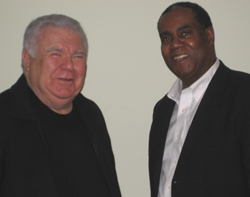
Jaime Lerner(l) and host Steve Curwood.(Photo: Eileen Bolinsky)
LERNER: Yes.
CURWOOD: And that line will cost, what, several billion dollars.
LERNER: 4 billion dollars.
CURWOOD: And if Jaime Lerner were in charge, you would do…?
LERNER: I could save some money for the city.
CURWOOD: Yeah? How exactly?
LERNER: The city of New York, they could transport two million passengers per day, and very, very with comfort, on surface.
CURWOOD: In buses.
LERNER: Buses, right now.
CURWOOD: And your method is high speed bus lanes? People pay for the bus before they get on the bus .
LERNER: Yes.
CURWOOD: And they come – how often do the buses come?
LERNER: You have to propose a good frequency. It has to be a reliable system. So the question is, don’t wait more than one minute, you’ll have a wonderful system.
CURWOOD: Not wait more than a minute for a bus?
LERNER: Yes.
CURWOOD: In Manhattan?
LERNER: Yes, you can do it.
CURWOOD: So, in all these years, what was the one thing that really amazed you, that just vastly exceeded your dreams?
LERNER: I remember, planting trees. We started a campaign in ’72. At that time we didn’t have the technology to having big trees. So we have small tree, we had to plant very small trees – so that means that you have to take care. We made the campaign, so we’re giving you the shade, you have to provide the water for the trees. I thought we were going to lose the half of the trees. We lost only five percent.
So what amazes me is how often the population – how people they react when they feel respected – when they understand something which is desirable. You have to trust in people, because they can do much better than you imagine. Always.
CURWOOD: Jaime Lerner is the three-time mayor of the Brazilian sustainable city Curitiba, and twice governor of the state of Paraná, Brazil. Thank you so much for coming by.
LERNER: Thank you.
Related links:
- To hear an extended version of Living on Earth’s interview with Jaime Lerner, click here
- To watch Jaime Lerner speak at the 2007 Technology, Entertainment, Design conference, click here
Greening Minneapolis
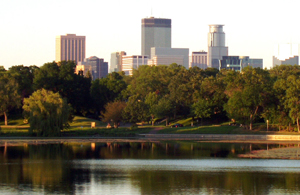
Minneapolis has been ranked the 11th greenest city in the United States. (Photo: Dan Oldre)
CURWOOD: From a sustainable city in Brazil, we take you now to the City of Lakes… Minneapolis, Minnesota. Earlier this month Minneapolis released its 2008 GreenPrint Report, updating progress that city has made towards its sustainability goals. R.T. Rybak is the mayor of Minneapolis and he joins me now on the line to talk about the greening of his city. Mayor Rybak, welcome to Living on Earth!
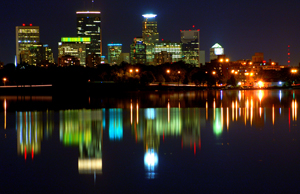
Downtown Minneapolis at night reflected in Lake Calhoun.(Photo: Dan Oldre)
CURWOOD: Now, Popular Science magazine recently rated Minneapolis the eleventh greenest city in the country – and I suppose you –
RYBAK: We demand a recount.
CURWOOD: You demand a recount? Well, St. Paul was twelve.
RYBAK: (laughs) Well, that’s a wonderful thing. I think Minneapolis is doing some wonderful things. So are a lot of other people around the country too.
CURWOOD: Well, congratulations – but, of course, what are you going to do to be number one?
RYBAK: Well, I think one of the most important things is really engaging our citizens to be involved in those both big and little things that will make the city sustainable. So, uh, we’ve challenged everyone to be part of the, what’s called the Minnesota Energy Challenge. They look at their own lifestyle – the city does as well – and we collectively try to reduce, uh, as much of our CO2 as possible, and, uh, so far we’ve had about 3100 citizens sign up to save 21 million pounds.
CURWOOD: Tell me about, uh, your specific grant program to help Minneapolis deal with climate change.
RYBAK: We put out micro-grants, uh, $1000 to $10,000, and had a series of actions – some as small as a community organizing group working with Somali women, teaching them to ride bicycles so they can commute that way. Another neighborhood organization distributing clothes lines to replace dryers. A lot of community organizing along the idea of what you can do in your own neighborhood.
CURWOOD: What can a city like Minneapolis do in the face of gasoline headed to $4 and $5 a gallon or more, and of course it does generate carbon dioxide when it comes back out the tailpipe. In particular, what are you doing to get people out of their cars?
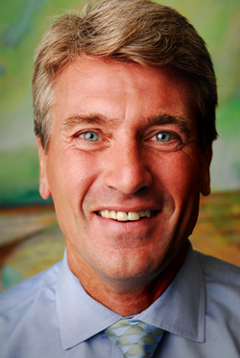
R.T. Rybak has been the mayor of Minneapolis since 2001. (Courtesy of Mayor R.T Rybak’s office)
Minneapolis’ climate is not perfect in the winter –
CURWOOD: Yeah. (laughs)
RYBAK: But it is the second best bike commuting city in the country. And that’s what’s so incredible about the people here, is it’s not an impediment.
CURWOOD: The Mississippi River runs right through the middle of parts of Minneapolis. It’s not particularly clean there. What are you doing to improve water quality?
RYBAK: One of the things that happens when you get a new job like mayor is that they give you a bunch of dirty little secrets you didn’t know about when you first, uh, wanted the job.
CURWOOD: (laughs)
RYBAK: In my second week in office, they came in and told me about what was called combined sewer overflow – that when there were extreme rains, that our system would overflow and raw sewage would go into the Mississippi. Well, that was obviously not something that we could tolerate. So we launched a very aggressive program to prevent those overflows, and it involved working with building owners to have them disconnect from the sewer system. It dealt with giving credits to homeowners for permeable surfaces so the water would seep in. Rain gardens, roof top gardens. And I’m really proud to say that as of last summer, we had no incidents of that – which was very good.

Minneapolis was ranked the 11th greenest city in the United States.(Photo: Dan Oldre)
CURWOOD: In the short term, though, how do you pay for all this?
RYBAK: Well, you have to make choices, and there is a, green premium that people pay, and I think that’s wrong – but I think we also have to take those aggressive steps, even if it means a little more in the short term. And I think we need to get ourselves back in harmony with the planet. That doesn’t mean having your head in the sky. But it does mean really laying out to citizens what’s at stake here.
I talk a lot about the natural beauty of the extraordinary place we call Minnesota. And Minnesota sits, um, in a pre-settlement, where the big woods met the prairie. If we think about that, and think about the poetry of a prairie and a big woods, think about a place where water flows in three directions – people begin to reconnect with the, uh, the land that they’re part of. You do not destroy something you love. And I think we have so taken our land for granted, that the more we connect people back to the magic of the places we live in – the more they will respect them and take the tough actions that we all need to take to be, uh, living in better harmony.
CURWOOD: R.T. Rybak is mayor of Minneapolis, Minnesota. Thank you so much, Mr. Mayor.
RYBAK: Thank you. It’s fun to talk about this.
Related link:
City of Minneapolis Sustainability Initiatives
Earth Day at 38
CURWOOD: Today, thirty-eight years after the massive demonstrations of the first Earth Day, things have never been as bad for the environment.
World population has ballooned from less than three billion to over six billion, and it’s still rising, along with greenhouse gas levels that are on course to ignite climate catastrophe. Species continue to disappear, and just recently we heard about some salmon of the Pacific Northwest apparently going the way of the buffalo, passenger pigeon and dodo. If that’s not enough bad news, government researchers are now telling us that a chemical widely used in plastic water and baby bottles called Bisphenol A might be harmful to children’s brains and reproductive organs.
Whew!
And as the environment gets poorer, so do people.
Some folks made a lot of money in the tech and real estate booms, but as each bubble has popped, as a whole we’ve slipped further behind. Today’s credit crunch, the weak American dollar and soaring gas prices show the tightening that’s been going on. I only have to look at my own life to get a handle.
Just before Earth Day 1970 I was earning my way through college as a junior fill-in radio engineer for CBS. That summer job paid $500 a week with overtime. Ten weeks pay covered half of my college tuition, plus a summer apartment and upkeep for a car and a motorcycle. Full time would have been $25,000 a year.
These days there is almost no way a college kid is going to pay for half of private college tuition by working a ten-week job. In fact he’s likely to move back home after graduation. So what happened? Today my summer job pay, adjusted for inflation, comes to an annual salary of $180,000. That’s more than the salary of a United States Senator.
So the middle class has been getting poorer, even as the rich are getting richer. And what does this have to do with the environment?
When people are poor there is no time for sustainability. There is no money to update or replace energy hogging homes and cars when credit cards are maxed out. And there’s no time to cook a meal of locally grown food when all the adults in a household have to work every day just to afford a fast food drive thru.
So it’s clear that when our economy is down, so is our environment. And when our environment is down, so is our economy. Dirty air, dirty water, congestion, disease and disability – not to mention the stronger storms and floods and droughts of climate disruption are all costing billions if not trillions to address.
The lesson of ecology is that everything is connected. So it’s up to us to connect those dots, to act as a community that can share and work together to find simple solutions, rather than maximize individual advantage.
This Earth Day should remind us all that we have the responsibility to turn around our environmental and economic decline. But at this crucial moment we won’t succeed without strong and visionary leadership, and as this is a democracy, those choices are up to us.
[MUSIC: : Ketil Bjonstad/Terje Rypdal “Flotation And Surroundings” from Life In Leipzig (ECM Records 2008)]
CURWOOD: In honor of earth day we leave you this week with some voices from the western part of the country.
PERSON1: Me myself I recycle, I take the cans and I put em in separate bags and, you know, that’s as much as I feel like I can do.
CURWOOD: Living on Earth’s Ashley Ahearn asked people from California to Arizona to Missouri what they’re doing to care for their patch of America.
VOX: Well, we try to grow some of our own food, and raise some of our own food with chickens and beef, and a nice vegetable garden. At home I use a portable heater, to heat only one room, you know, bed room and other than that we don’t use the heater. Well it’s easier to say than do. We have our air conditioning set at 80 in the summer we have our heat set at 65 in the winter, and our kids when they come say – “oh it’s so cold in here” in the winter and I say “put on a sweater!” – every day is Earth Day!
[MUSIC: : Ketil Bjonstad/Terje Rypdal “Flotation And Surroundings” from Life In Leipzig (ECM Records 2008)]
CURWOOD: Living on Earth is produced by the World Media Foundation. Our crew includes Ashley Ahearn, Bobby Bascomb, Eileen Bolinsky, Ingrid Lobet, Helen Palmer, Mitra Taj and Jeff Young, with help from Jennifer Baessler and Sarah Calkins.
Our interns are Annie Jia and Margaret Rossano. Jeff Turton is our technical director. Alison Lirish Dean composed our themes. Steve Curwood is our executive producer. You can find us at LOE dot org. I'm Steve Curwood. Thanks for listening.
ANNOUNCER1: Funding for Living on Earth comes from the National Science Foundation, supporting coverage of emerging science, and Stonyfield Farm – organic yogurt and smoothies. Stonyfield pays its farmers not to use artificial growth hormones on their cows. Details at stonyfield.com. Support also comes from you our listeners, the Ford Foundation, the Town Creek Foundation, the Oak Foundation, supporting coverage of climate change and marine issues and Pax World Mutual Funds: socially and environmentally sustainable investing. Pax World: for tomorrow. On the web at paxworld.com.
ANNOUNCER2: PRI, Public Radio International.
Living on Earth wants to hear from you!
Living on Earth
62 Calef Highway, Suite 212
Lee, NH 03861
Telephone: 617-287-4121
E-mail: comments@loe.org
Newsletter [Click here]
Donate to Living on Earth!
Living on Earth is an independent media program and relies entirely on contributions from listeners and institutions supporting public service. Please donate now to preserve an independent environmental voice.
NewsletterLiving on Earth offers a weekly delivery of the show's rundown to your mailbox. Sign up for our newsletter today!
 Sailors For The Sea: Be the change you want to sea.
Sailors For The Sea: Be the change you want to sea.
 The Grantham Foundation for the Protection of the Environment: Committed to protecting and improving the health of the global environment.
The Grantham Foundation for the Protection of the Environment: Committed to protecting and improving the health of the global environment.
 Contribute to Living on Earth and receive, as our gift to you, an archival print of one of Mark Seth Lender's extraordinary wildlife photographs. Follow the link to see Mark's current collection of photographs.
Contribute to Living on Earth and receive, as our gift to you, an archival print of one of Mark Seth Lender's extraordinary wildlife photographs. Follow the link to see Mark's current collection of photographs.
 Buy a signed copy of Mark Seth Lender's book Smeagull the Seagull & support Living on Earth
Buy a signed copy of Mark Seth Lender's book Smeagull the Seagull & support Living on Earth

